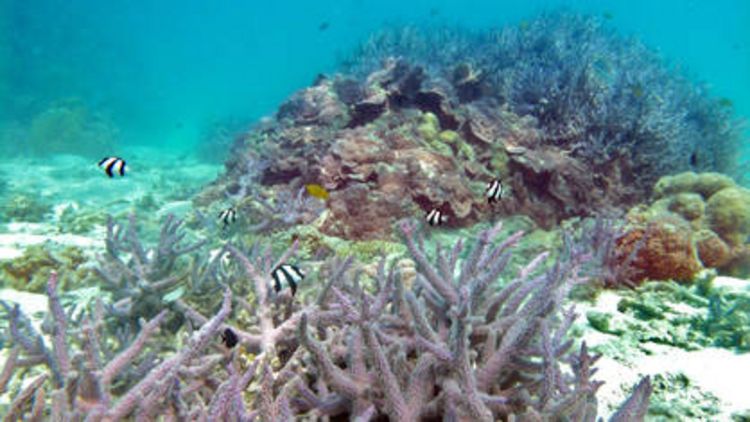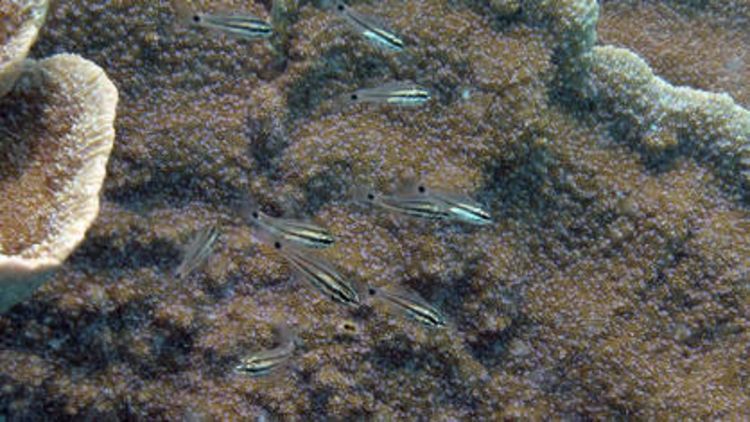The larvae of coral reef fishes swimming in the ocean are just a few millimetres long. And yet they are able to find their way back to their native reef across distances of several kilometres. Oldenburg biologist Gabriele Gerlach has been studying precisely how they do this on Australia's Great Barrier Reef.
Just a few weeks after hatching on Australia's Great Barrier Reef, millions of coral reef fish larvae set out on an expedition during the hot Australian summer months from December to February. Swept by the tide into the open sea, known as the pelagic zone, they embark on their voyage.
Their journey is similar to that of salmon returning to the river where they were born during the spawning season. Prof. Dr. Gabriele Gerlach, a biologist at Oldenburg, recently spent several weeks at the One Tree Island Research Station on the Great Barrier Reef studying the navigation skills of reef fish larvae.
Gerlach's extended stay at the One Tree Island Research Station was made possible by the Australian National Network in Marine Science (ANNiMS). The network is the product of collaboration between the universities in Townsville, Perth and on the island of Tasmania. It chose Gerlach as its Visiting Scholar 2012 in recognition of her research work on coral reefs and on the migration and navigation mechanisms of fish.
How do coral reef fish find their way back to their native reef?
"Despite all the dangers, the survival chances of reef fish larvae are greater out in the ocean than on the reef itself or in the proximity of adult fish," Gerlach explains, adding that it nonetheless remains a mystery where exactly the larvae go, and how far away from the reef they stray.
But depending on the species, after a certain amount of time they must seek out another reef again because out in the open water the tiny fish can't develop into adult fish. For a long time where the currents and storms brought the larvae to was considered to be a matter of pure chance. Then the first reports of many larvae returning to the reef where they originated started to appear just over a decade ago. Since then, Gerlach has been researching the navigational behaviour of coral reef fish. Because without a special sensory skill, she points out, they would not be able to find their way back to their native waters.
To track the fish, Australian researchers use a special marking method: they expose the eggs and freshly hatched larvae to an antibiotic for a few hours. This has the effect of colouring the daily growth ring located in their tiny ossicles green. The homecoming larvae can then be easily identified on the basis of their colouring.
DNA microsatellites used to identify the larvae's population of origin.
The researchers calculated the probability of larvae returning to their native waters at between 35 and 60 percent. Gerlach, an expert on biodiversity and animal evolution, relies on a different method to track the journeys of the fish larvae: "Similar to the way criminals are identified using DNA samples, microsatellite DNA analysis can be used to determine the population of origin of the larvae." Cardinalfishes (Ostorhinchus doederleini) were used for the experiments.
Gerlach's hypothesis was that if the larvae returned to their native reef, as adult fish they must also be genetically distinguishable from members of the same species on neighbouring reefs. In the course of her research in Australia the biologist was able to prove precisely that: the fish that inhabit the same reef are closely related to each other and genetically different to members of the same species inhabiting neighbouring reefs.
Scientist finds out that larvae have a sense of smell.
But the question remains: How can fish larvae that are just a few millimetres long and that frequently swim several kilometres away from their native reef find their way back? In 2007 Gerlach provided an initial answer to this question in an article published in the renowned science journal PNAS (Proceedings of the National Academy of Sciences). The article caused quite a stir.
Together with Australian marine biologist Michael J. Kingsford of the James Cook University in Townsville and American scientist Jelle Atema of Boston University she discovered that the larvae possess a sense of smell that helps them to navigate in the open sea.
"When after a typical period of three weeks in the open sea they make the journey home, the larvae display an olfactory preference for their native reef. This means that the water that flows off the reef's lagoon at low tide bears olfactory characteristics typical of the reef, Gerlach explains.
The larvae smell the scent of "their" reef.
In a test arrangement the researchers presented young fish with water from five neighbouring reefs that form part of the Great Barrier Reef. "The larvae displayed a preference for the water of their genetically determined native lagoon over water samples from other reefs. They could smell the specific "scent" of their reef and swam directly towards it," the scientist notes.
However this olfactory account does not entirely explain the phenomenon. The smell of the reefs cannot spread everywhere in the ocean. When the larvae are carried kilometres away from the reef by currents, at some point their sense of smell is no longer strong enough to point the way back.
So how do the fish navigate across large distances? This question remains unanswered. Gerlach is trying to solve the puzzle - together with Prof. Dr. Henrik Mouritsen, also a biologist at the University of Oldenburg and an expert on the navigation of migratory birds. The two Oldenburg scientists are examining whether mechanisms similar to those used for long-distance navigation by migratory birds could also be at work here.
This article also appears - together with an interview with Gabriele Gerlach - in the July edition of the University magazine UNI-INFO.


